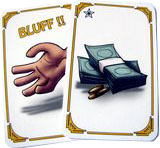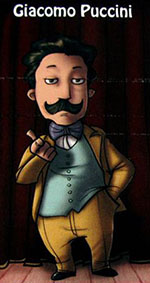
Components

- 36 pro singer cards
- 36 amateur singer cards
- 36 alternative singer cards
- 36 classic singer cards
- 36 comic singer cards
- 36 dark singer cards
- 1 costume designer
- 1 carpenter
- 9 directors
- 6 characters from the Opera
- 1 card with the maestro
- 55 player cards
- Instructions
Object of the Game
Your goal is to recruit a cast of singers to stage the Turandot, a famous opera by Giacomo Puccini. You will also need to hire a director who will give the work his personal touch. You can score bonus points by hiring a costume designer or a carpenter.
But ultimately, the score for your opera will be determined by the quality of your singers, and assigning them to the roles they most desire. At the end of the game, whoever has scored the most points will be the winner!
Setup
Place the 6 characters face up in the middle of the table, in a row going from 1 to 6. Place the costume designer and the carpenter face up beside the characters.
If you are playing with 2 or 3 players, remove the carpenter from the game and use only the costume designer.
Each player chooses a color and takes the 11 matching cards: six number cards, three money cards, a bluff card, and a summary card. You always use all the money, bluff, and summary cards.
 Money and Bluff card |
But the number cards you will use depends on the number of players: use all six cards if you have five players; otherwise, use only the cards that correspond to the number of players plus one.
In a four-player game, for instance, use the cards numbered from 1 to 5. Keep the summary card face up in front of you, and take the other cards into your hand. Remove any unused cards from the game.
Shuffle the singers, and place this deck face down by the characters. Place the directors face up in a pile nearby: you will need them later on.
The player who can sing the best takes the Puccini card and places it face up in front of him.
Game Play
The game lasts seven rounds. Each round is divided into phases (three phases in the first three rounds, and two phases per round for the rest):
- Casting Call
- Hire Cast
- Fire a Director (but only during the first three rounds!)
During each round, you will recruit one singer, except in the fourth round, when you will instead recruit one director. At the end of the game, you will have recruited six singers (during rounds 1, 2, 3, 5, 6, and 7) and one director (during round 4).
The Turandot opera requires four men (playing Calaf, Ping, Pong, and Pang) and two women (playing Turandotand Liu), if at all possible!
Phase 1: Casting Call
The player holding Puccini turns over a number of singers from the deck equal to the number of players plus one. Place one singer below each character card, starting with number 1. If you are playing with less than five players, some characters will have no singer beneath them.
 Example set-up with 4 Players |

Now each player secretly chooses which singer to recruit. Select one or more cards from your hand, and play them face down in front of you. You can play:
One number card; or
One number card and one or more money cards; or
One money card without a number card.
You can always choose to include your bluff card along with your number or money cards. This card is used to disguise the number of cards you play, so that the other players won't know what you are doing. (The bluff card is not counted during phase 2).
Once all players have chosen, the cards are revealed at the same time. Now you are ready to hire the singers (phase 2).
Phase 2: Hire Cast
During this phase, each player will receive one of the singers, using the following rules:
-
if you are the only player who played a given number card, you take the singer beneath the character card which shows that number and place it face up in front of you.
If you played any money card(s) along with the number card, then the money is discarded (it was used to hire the singer);
-
if more than one player played the same number card, there are two possibilities:
if one of these players also played more money cards than the others, he is clearly the high bidder. He takes the matching singer and discards all the money he played.
The other players take their money back, and they will get an "understudy" singer (see below);if some or all of these players played the same number of money cards (even zero!) there is a tie: all the players who played the matching number card take their money back, and they will all get an "understudy" singer (see below);
-
if you played only one money card (and no number card), then you can try to hire the costume designer or the carpenter (both cards have the same effect).
If you do not play a number card, you will always get an "understudy" singer, even if you don't manage to hire the costume designer or the carpenter.
There are 3 possibilities:
only one player has played a money card: he takes the costume designer;
two players have played a money card: one of them takes the costume designer, the other one takes the carpenter;
three or more players have played a money card: the costume designer and the carpenter are assigned to two of these players starting with the player who has Puccini and going clockwise.
If you played only a money card and you do not get the costume designer or the carpenter, take your money card back.
If you hire the costume designer or the carpenter, you must immediately turn your played money card into an element of the scene: place the money card face up in front of you beside your singers (showing the star). At the end of the game, this card is worth 1 point!

costume designer
Important: the player with Puccini may not hire the costume designer or the carpenter!
Remember: with 2 or 3 players, only the costume designer is used, and the possibilities above must be adapted.
Example 1: Steven played number card "3", along with a money card, as he wants the singer under character number 3. Since no other player has played number card "3", he takes the singer and places it face up in front of him. Then he discards the money card.
Example 2: Both Steven and John played number card "4". John also played two money cards, while Steven played only one money card.
John is clearly the higher bidder, so he takes the matching singer and discards his money cards. Steven takes his money card back into his hand, and will receive an understudy singer.
Example 3: Steven, John, and Patty all played number card "2", and one money card each. Since it is a tie, they all take their money cards back, and get an understudy singer.
Example 4: Steven played number card "2" and two money cards. John also played card "2" and two money cards. Patty played number "2" but only one money card.
Again, this is a tie: Steven and John offered more than Patty, but they tied. All three take back their money and get an understudy singer.
Understudy Singers

After the steps above are complete, it is possible that some players won't have a singer for this round yet (e.g., in case of ties, hiring the costume designer, etc)..
These players each receive an "understudy" singer. The player with Puccini chooses which of the remaining singers to give to each of these players. If the holder of Puccini also needs an understudy singer, then he chooses one for himself.
At the end of phase 2, there will always be one singer left unhired, which will be discarded from play (see below).
Phase 3: Fire a Director

(only during the first three rounds)!
During the first three rounds, one of the directors will be fired and removed from the game.
The player with Puccini chooses any other player. The chosen player fires a director: take the pile of directors, choose one, and remove it from play after showing it to all players.
A New Round
The singer who has not been hired by any player is removed from the game. Players take their number cards back (along with any money cards they did not use to hire singers or turn into an element of the scene).
The player with Puccini passes the card to the player on his left, who will hold it for the following turn.
The costume designer and the carpenter are placed back in the middle of the table and are once again available for hire. Remember that all singers and the director you hire are kept visible in front of you.
The Fourth Round: Hiring a Director
The fourth round (after all players have hired three singers) is played similarly to the other rounds, except you will hire a director instead of a singer.
Instead of placing a set of singers, the player with Puccini shuffles the pile of directors (at this point, the pile will have only six cards, since three were removed during the first three rounds), and draws as many directors as there are players, plus one.
As with the singers, place the directors face up below the row of characters, starting from the number 1. Any leftover directors are removed from play.
The round is played as normal with one exception: during this round the costume designer and the carpenter are not available and cannot be hired.
Once allocated, keep your director face up beside your singers.
Directors can increase or decrease your total points at the end of the game, depending on your cast:

End of the Game
At the end of the seventh round, the game ends and players tally their points.
At the end of the game you will have six singers and one director. You must assign each of your singers to one of the six roles in the opera.
Follow the order given by the character cards: the first singer plays Turandot, the second Calaf, the third Liu, then Ping, Pong, and finally Pang.
You should try to match the gender of the singer with the one required by the role (i.e. Turandot and Liu with women, Calaf, Ping, Pong, and Pang with men) otherwise you will lose points.
Then, calculate your score:
-
add up all the stars on your singers (each star is worth one point);
-
add the total number of elements of the scene (the stars on your money cards in front of you);
-
add one point for each of your singers playing his or her favorite role. Some singers prefer to play a particular role. This preference is indicated on the cards with the following symbols:

-
subtract one point for each of your singers playing a role of a different gender. There is a symbol on each card representing the gender of the singer:

A singer of "uncertain" gender can play any role without penalty.
-
last, add and/or subtract the points for your director.
The player with the most points is the winner!
In case of a tie, the winner among the tied players is the one with the most points counting only his singers, with no bonuses or penalties. If they are still tied, the victory is shared.
Special rules for two players
Play proceeds as normal with the following exceptions:
use only the costume designer and do not use the carpenter (remember: this also applies when playing with 3 players);
during each turn, the unallocated singer or director is not discarded. Instead, place it to the side so that it creates the hand of a "dummy" player;
the cards of the dummy player are kept in the same order they are taken from the table; in other words, you can't rearrange the cards of the dummy player at the end of the game;
Puccini stays with the two players, alternating back and forth (i.e., Puccini is never given to the dummy player);
the player with Puccini at the end of the game loses 1 point;
at the end of the game, tally the score of the dummy player. If this score is higher than both the scores of the players, then the dummy player wins and both players lose the game!
Continue Reading
